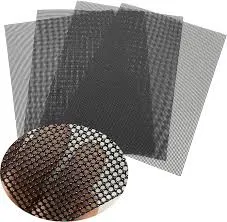-
+86 15030157877
-
sales@galvanizedmetalmesh.com
dec . 12, 2024 11:24 Back to list
galvanized barbed wire exporters
The Dynamics of Galvanized Barbed Wire Exports An Overview
Galvanized barbed wire, a staple in the fencing and security industry, plays a crucial role in protecting properties, livestock, and agricultural territories. As globalization accelerates and trade networks expand, the export of galvanized barbed wire has witnessed notable growth. Exporters in this industry are capitalizing on the increasing demand from various sectors, including agriculture, construction, and security, both domestically and internationally.
Understanding Galvanized Barbed Wire
Galvanized barbed wire is produced by coating steel wire with a layer of zinc to prevent corrosion and ensure longevity. This process makes it ideal for outdoor uses, where exposure to atmospheric elements can lead to rapid deterioration. The barbs created at regular intervals enhance its security aspect, making it difficult for intruders to breach fenced areas. Its applications range from fencing agricultural lands to securing industrial properties, and even military installations.
Increasing Global Demand
Several factors contribute to the rising demand for galvanized barbed wire globally. The need for enhanced security measures in both urban and rural areas has led to increased sales. Countries experiencing rapid urbanization often see a surge in fencing requirements to protect residential areas and vital infrastructure. Furthermore, the agricultural sector, especially in developing nations, relies heavily on barbed wire to manage livestock and protect crops from wildlife.
Emerging economies that are investing in infrastructure and housing projects are also key markets for galvanized barbed wire. Countries in Africa, Asia, and Latin America are witnessing growth in construction and housing, leading to increased fence installations for both safety and aesthetic purposes.
Key Export Markets
The primary export markets for galvanized barbed wire include the United States, Europe, Asia-Pacific, and parts of Africa. The United States remains one of the largest consumers of fencing materials, driven by its extensive agricultural activities and the need for secure perimeters for industrial facilities. In Europe, countries with large agricultural sectors, such as Germany and France, have demonstrated consistent demand for high-quality fencing solutions.
Meanwhile, in Asia-Pacific, nations like India and China are ramping up their production and consumption of galvanized barbed wire, fueled by rapid industrialization and population growth. Africa also presents a rising market, as countries invest in securing land and resources in response to increasing population density and wildlife conflicts.
Challenges for Exporters
galvanized barbed wire exporters

Despite the positive outlook, exporters of galvanized barbed wire face several challenges. Tariffs and trade regulations can significantly impact pricing and competitiveness in foreign markets. Additionally, fluctuations in the cost of raw materials, primarily steel and zinc, can affect profit margins. Exporters must also navigate varying standards and regulations in different countries, which can complicate the export process.
Supply chain disruptions caused by global events, such as the COVID-19 pandemic, have also posed challenges. Delays in shipping and increased freight costs can hinder timely deliveries, thus impacting customer satisfaction and leading to potential loss of business.
Strategies for Success
To remain competitive in the global market, exporters of galvanized barbed wire should focus on several strategic areas
1. Quality Assurance Emphasizing the quality of products can differentiate exporters in a crowded market. Certifications and adherence to international standards can build trust with buyers.
2. Market Research Understanding the specific needs of different markets can help exporters tailor their products and marketing strategies accordingly.
3. Diversification Expanding the range of products offered, including varied sizes and types of barbed wire, can attract a broader customer base.
4. Sustainable Practices Implementing eco-friendly practices in production and packaging can appeal to environmentally conscious consumers and set a brand apart.
5. Strategic Partnerships Collaborating with local distributors and partners in target markets can enhance sales and improve market penetration.
Conclusion
The export landscape for galvanized barbed wire is characterized by both opportunities and challenges. With a focus on quality, strategic market engagement, and adaptation to consumer needs, exporters can thrive in this dynamic industry. As the global market continues to evolve, galvanized barbed wire will undoubtedly remain an essential component of security and fencing solutions worldwide.
-
Welded Gabion Solutions: Durable & AI-Enhanced Designs
NewsAug.01,2025
-
Premium Welded Gabion Mesh | Robust & Eco-Friendly
NewsJul.31,2025
-
Premium Eco-Friendly Roof Tiles | Affordable & Durable
NewsJul.31,2025
-
Premium Roof Tiles for Durable & Stylish Roofing Solutions
NewsJul.30,2025
-
High-Quality Roof Tiles for Durable & Stylish Roofing Solutions
NewsJul.29,2025
-
High Quality Square Wire Mesh Manufacturer & Supplier for Wholesale
NewsJul.29,2025



